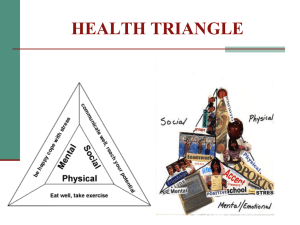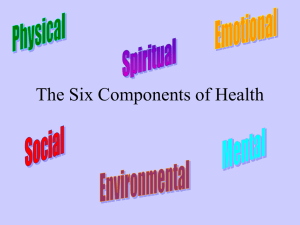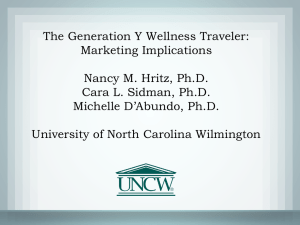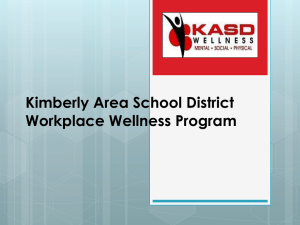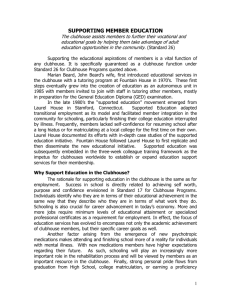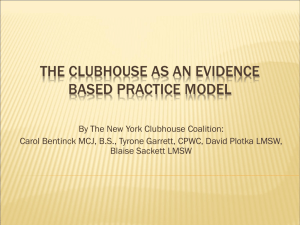How We Can Develop Wellness Programming - NAMI-NC
advertisement
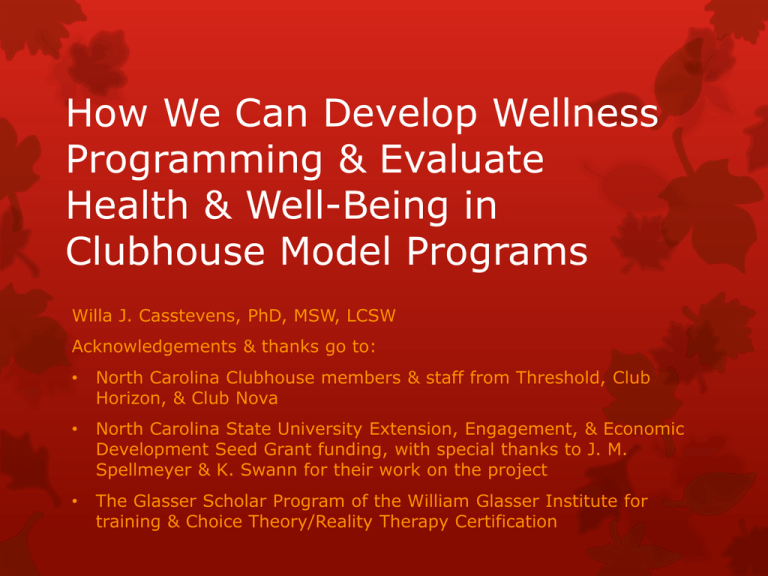
How We Can Develop Wellness Programming & Evaluate Health & Well-Being in Clubhouse Model Programs Willa J. Casstevens, PhD, MSW, LCSW Acknowledgements & thanks go to: • North Carolina Clubhouse members & staff from Threshold, Club Horizon, & Club Nova • North Carolina State University Extension, Engagement, & Economic Development Seed Grant funding, with special thanks to J. M. Spellmeyer & K. Swann for their work on the project • The Glasser Scholar Program of the William Glasser Institute for training & Choice Theory/Reality Therapy Certification ICCD Clubhouse Model Clubhouses serve adults diagnosed with severe & persistent mental disorders Clubhouse International: www.iccd.org Clubhouses emphasize Relationships Support A work-ordered day Clubhouses are relatively small not-for-profit agencies designed to provide community membership psychosocial rehabilitation Dr. William Glasser & Choice Theory www.wglasserinternational.org Choice Theory tells us that We can only control our own behavior We cannot control other peoples’ behavior We have five Basic Needs Survival Love & belonging Power or recognition Freedom Fun & learning Our most important Basic Need is LOVE & BELONGING which refers to closeness & connectedness with the people we care about Choice Theory: The Quality World Our Quality World can be seen as a "personal picture album" of all the people, things, ideas, and ideals that we have discovered increase the quality of our lives Everyone’s Quality World is unique, because the things we value are different for each of us Our Quality Worlds change over time Choice Theory: Total Behavior One of the Ten Axioms of Choice Theory is “All we do is behave” (wglasser.com) All behavior is Total Behavior & made-up of 4 components Acting Thinking Feeling Physiology Almost all behavior is chosen We can choose to directly control our Acting & Thinking We can only control our Feeling & Physiology indirectly, by how we choose to act &/or think Choice Theory & Reality Therapy Reality Therapy Based on Choice Theory Developed by Dr. William Glasser Dr. Robert Wubbolding subsequently developed the WDEP Model of Reality Therapy WDEP Model of Reality Therapy W = wants & needs D = doing & direction E = evaluation P = planning How We Can Use Choice Theory to Develop Wellness Programming Build from the ground up! (not the top down) Clubhouse members are central to the process Focus group series The series consists of 4 open groups Voluntary participation – include members & staff Groups are held weekly at the Clubhouse Groups can support &/or generate interest in topic (which is health & wellness) Group I: Wants/Needs Explores health & wellness related pictures in participants’ Quality Worlds Asks about participants’ their wants & needs related to health & wellness Questions (1) how do you view your health? (2) would you like to improve it? (3) what would this mean to you? Group II: Doing/Direction & Evaluation Examines health & wellness related aspects of participants’ Total Behavior Considers what participants are doing & the directions this is taking them relative health & wellness Helps participants evaluate how their choices are working out Questions (1) what do you do now that helps you feel better? (2) what have you done in the past that helped you feel better? (3) how have these things worked out? Group III: Planning Encourages participants to let go of External Control Psychology & to start planning for health & wellness related goals Helps participants with planning health & wellness related choices Questions (1) what do you think it would take for you to feel better? (2) what can you do that might help this happen? (3) what could the Clubhouse do that might help you make this happen? Group IV: Planning Specifically considers the planning process & encourages suggestions for change at the Clubhouse Questions (1) what could happen at the Clubhouse that would help you feel better? (2) what could staff do at the Clubhouse that would help you feel better? (3) what could you do at the Clubhouse (and/or at home) that would help you feel better on an ongoing basis? Three North Carolina Clubhouses’ Initial 2009 Health & Wellness Programming Threshold Club Horizon Club Nova •In Durham, NC •In Knightdale, NC •In Carrboro, NC •24 years old •7 years old •22 years old •85 active members •72 active members •90 active members •Average daily attendance = 60 •Average daily attendance = 47 •Average daily attendance = 43 1. Fresh Produce from Durham Farmers’ Market & Interfaith Food Shuttle 2. Healthy changes in Snack Bar & Lunch menus 3. Nutrition Education – Durham County Public Health & Interfaith Food Shuttle 4. Health Education – Durham County Public Health 5. Sexual Health Education – Durham County Public Health 6. Walking Group ongoing 1. Fresh Produce from State Farmers’ Market in Raleigh & Interfaith Food Shuttle 2. Healthy menu planning & additions to Snack Bar 3. Health Education – Wake County Public Health 4. Knightdale Parks & Recreation outings 5. Walking Support Group ongoing 6. Wii Fit Activity donated/available 7. Exercise equipment purchased using tobacco settlement funds 1. Fresh Produce from Local Coop & Farmers’ Markets 2. Desserts removed from Lunch menu 3. Psychotropic Medication Education – nurse volunteer 4. Nutrition Education – UNC student volunteers 5. Safety Education – Fire Marshall & Clubhouse staff 6. Weekly exercise, e.g., walks 7. Creative Activities during Socials: a. Candle-making b. Crocheting c. Art & Music Similarities / Differences All 3 Clubhouses included: Healthy changes to menus Obtaining fresh fruits & vegetables Walking groups Unique aspects included: Advertising health programming Including creative projects & activities Pitfalls in Developing / Maintaining Wellness Programming Can Include Preconceptions in note-taking during groups Staff turnover Low support from staff Lack of direct support from administration Objections from Board members or officers Evaluation! Can take place within the work-ordered day Recording options Paper forms & file folders Excel pages & saved data files Equipment can include Scale Blood pressure cuffs in the appropriate sizes Tape measure Standardized instruments can be used at longer intervals Instrument options: Quality of Life Inventory (QOLI) available through Pearson 36-Item Short Form Survey Instrument available online Track weekly measurements, for example Weight Waist Blood pressure Track healthy foods eaten, for example Fresh fruits & veggie portions Other vegetables, unless fried Set individualized goals and update your progress! References Casstevens, W J (2011). A pilot study of health and wellness program development in an ICCD clubhouse. Psychiatric Rehabilitation Journal, 35(1), 161-240. Casstevens, W J (2013). Health and Wellness at a Clubhouse Model Program in North Carolina: A Choice Theory Based Approach to Program Development and Implementation. International Journal of Choice Theory and Reality Therapy, 32(2), 48-53. Casstevens, W J, & Cohen, M B (2011). A groupwork approach to focus group research in a psychiatric clubhouse program. Groupwork, 21(1), 46-58. Glasser, W (1998). Choice theory: A new psychology of personal freedom. NY: HarperCollins. Glasser, W (2000). Counseling with choice theory: The new reality therapy. NY: HarperCollins. Threshold Clubhouse (2011). Implementing a health and wellness program within a clubhouse model program. Presentation at the 18th Annual STEP Symposium, Chapel Hill, North Carolina. Wubbolding, R E (2000). Reality therapy for the 21st century. NY: Routledge.



